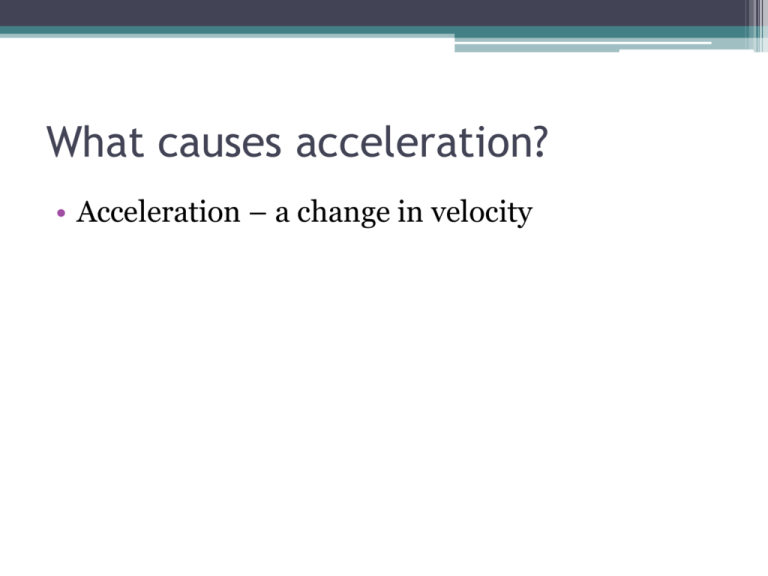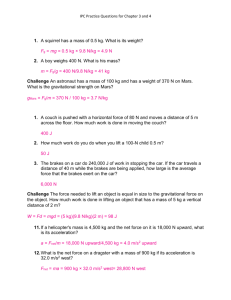Forces, FBDs, Newtons laws
advertisement

What causes acceleration? • Acceleration – a change in velocity Answer the following questions: 1. Do all forces cause acceleration? 2. Give an example where a force does cause acceleration and an example where it does not. 3. How is the force you apply related to the direction of acceleration? 4. What if two people were pushing equally in opposite directions on an object, what would happen? Forces and Free Body Diagrams What is a force? • Force ▫ any push or pull ▫ Measured in Newtons (N) • Most forces involve contact (pushing a car) with the exception of action at a distance forces ▫ These forces do not require the two objects putting force on each other to touch ▫ Ex. Gravitational force, magnetic force Types of Forces • Using page 27, for each force describe: ▫ Description: ▫ Direction it acts: • Leave some space below each description for diagrams Drawing Free Body Diagrams Steps: 1. Draw a box on the appropriate surface 2. Draw a dot at the centre 3. Draw and label an arrow for each force present Examples 1. A car sitting on a flat road 2. Car being pulled by a rope over a flat surface 3. Car being pushed up a ramp 4. Car suspended by a string Calculating Net Force • Net Force – the sum of all the forces on an object FNET = F FNET,X = FX FNET,Y = FY Calculating Net Force • Net force ▫ the resulting force if you add all the forces acting on a single body ▫ Not an actual force but it results from actual forces ▫ The only force that you can see the effect of • Tug of war example • For these types of problems, you must ALWAYS define a positive and negative direction and use these for your calculations Example • Miraj pulls with 200 N of force to the left on a rope. Reuben pulls with 300N of force to the right on a rope. What is the net force on the rope? Net Force Examples • On board Newton’s Second Law Newton’s Second Law • Acceleration is related to mass and net force FNET = ma FNET – Net Force (N) m – mass (kg) a – acceleration (m/s2) FNET = ma • What does this equation say? ▫ Directions are equal – direction of fnet equals direction of a (the object will accelerate in the direction of the net force) ▫ If net force is equal to zero, acceleration equals zero ▫ If force is constant, Mass increases, acceleration decreases Mass decreases, acceleration increases If net force is equal to zero, acceleration equals zero • What does zero acceleration look like? ▫ Object is not moving and stays not moving ▫ Object is moving at a constant speed and stays at that speed (zero acceleration means it does not change speed) Real Life •If you are late for school and stopped at a red light, do you want to be behind a full dump truck or an empty dump truck? Video Example Homework: • Pg 44 # 7 • Pg 45 # 1-4 Newton’s First Law of Motion Inertia Inertia – a property of matter that causes a body to resist a change in motion - Greater the mass, greater the inertia • Is it easier to move? ▫ A rock or a mountain? ▫ A smart car or a big rig? • Greater mass = greater inertia = more resistant to a change in motion Newton’s First Law • Objects at rest want to stay at rest • Objects in motion want to stay in motion • UNLESS, ▫ An unbalanced force (net force not equal to zero) is applied to them Summary • No net force, no change in motion • If the velocity is constant or zero, the net force acting on it must be zero • If velocity is changing (size or direction), new force is NOT zero Examples • • • • • Alien Tracker Beaker with pennies Air hockey table Dirt on a shovel Water off toothbrush Video Example Homework • Read about how a concussion is caused and write a paragraph which relates it to Newton’s Second law • Pg 36 # 5,6,8 • Pg 37 # 1,3 Newton’s Third Law • For every action there is an equal and opposite reaction • For every force, there is another force equal in magnitude but opposite in direction Examples • • • • • • • Rocket Wrench in space Getting out of a boat Swimming Fan boat Helicopter Recoil Video Work • Pg 48 # 1 • Pg 50 # 5,6 • Pg 51 # 2


